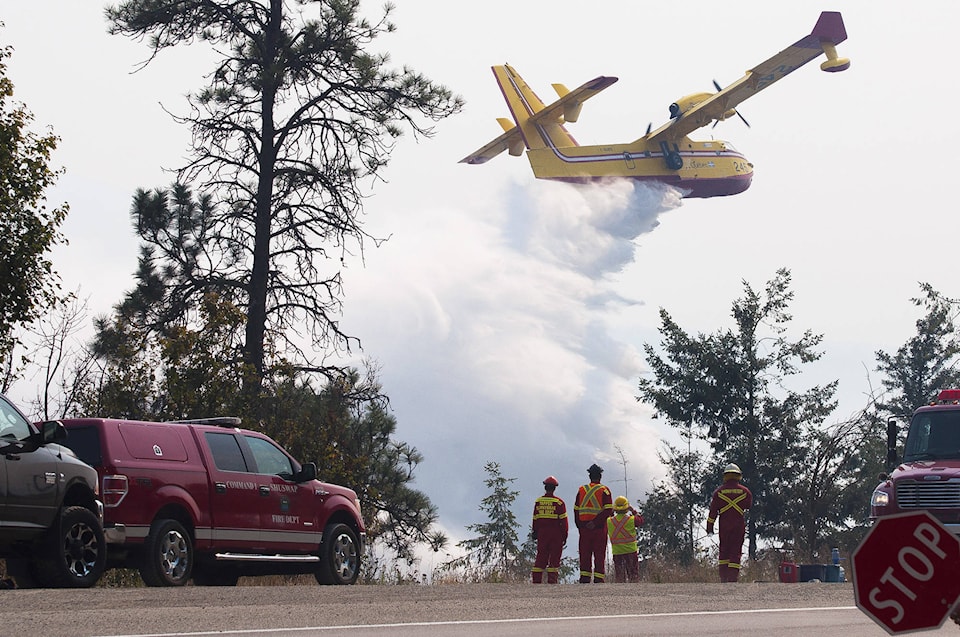Amidst the worst fire season in B.C. history, Salmon Arm got lucky.
That is the key message behind a report received by Salmon Arm council at its Jan. 15 meeting.
The report uses the 1998 Silver Creek fire to illustrate how fires can spread through the community.
The report tells the tale of the exceptionally destructive fire caused by a lightning strike in the Fly Hills on July 29 of that year. It reached a terrifying crescendo on Aug. 5, when the blaze crossed the Salmon River Valley, destroying homes while raining embers as large as baseballs.
Presented by Terry Smith, the general manager of Silvatech Consulting Ltd., the report is filled with details from the Omsbudsperson’s report about the conditions that led to the 1998 fire. It says many of those conditions remained through the hot, dry summer of 2017, only a lightning strike away from igniting another uncontrollable inferno. The report concludes the 1998 fire was just that – uncontrollable.
Smith said a change of wind was the only thing that saved Salmon Arm in 1998.
Silvatech’s report recommends drawing on funds available through the Union of British Columbia Municipalities (UBCM) Strategic Wildfire Prevention Initiative (SWPI) to help take a proactive approach to protecting Salmon Arm.
The report details how in 1998, the fire was spotted by an aircraft less than 10 minutes after starting and hit by the first tanker 40 minutes later. According to the report, 86,145 litres of retardant were dropped on the first day alone. A firefighting effort that used aggressive techniques and employed every resource available but still could not contain the fire is described in the report.
“The combined efforts of the fire bosses, the heavy equipment and initial attack crews on the ground, the full air attack force, a fully instituted per-organizational effort, all our modern technology and access to stand-by equipment could not put this fire out.”
The message to be gathered from the report is simple: No amount of fire fighting skill and equipment brought to bear on a fire in the hills above Salmon Arm after it has started can guarantee the city’s safety – preventative work must be done.
The report indicates Salmon Arm is an especially vulnerable community where wildfires are concerned because of its location with heavily forested mountains surrounding the community on three sides and the high incidence of lightning in the area.
“In 2017 we were very fortunate not to have had normal lightning storms pass through,” it reads.
Coun. Ken Jamieson said while he didn’t want to downplay the importance of preventative work, the conditions around Salmon Arm make the possibility of wildfires a constant concern.
“We need to appreciate we can’t annihilate the threat of fires around here,” he said.
The recommendations in the report include completing a community wildfire protection plan, a project that can be accomplished with 75 per cent of the funding coming from the provincial government. It also recommends planning to manage fuel in the wildland urban interface where forest areas that could fuel wildfires are adjacent to homes or other structures.
Coun. Tim Lavery said he believes the approximate $7,500 the city would have to pay to develop the community wildfire plan can be found. He noted it is less than the city spent on fireworks last year.
Coun. Alan Harrison expressed concern about Salmon Arm’s forested areas being reduced too much, changing the character of the community. He added he recognizes the challenges the forests create for protecting the community from fire.
Another proactive measure Silvatech’s report notes is that SWPI funding can go towards the employment of local First Nations firefighters, who Smith said have already done fuel management work in the area.
Neskonlith Band Coun. Louis Thomas said he was in the area for both the Silver Creek and Gleneden fires, and he sees the importance of having local people trained to respond quickly to fires.
